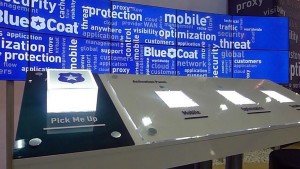
Blue Coat’s stand at the Earls Court Exhibition Centre in London PHOTO FROM BLUE COAT’S FACEBOOK.COM ACCOUNT
MANILA, Philippines—The BYOD (bring your own device) practice of using one’s own smartphones or tablets to complete assigned tasks at work has transformed the way today’s office workers achieve increased productivity.
While often permitted by bosses, BYOD has created corporate information security headaches because personal gadgets may be lost or stolen and along with it sensitive company data.
Though IT managers were able to develop policies and put together security strategies to deal with BYOD, they now have to contend with another risky practice: employees who bring in third-party or home-brewed apps into the corporate space. Dubbed as “bring-your-own-apps,” or BYOA, this practice has created another headache for IT managers who worry about unmanaged app usage in the workplace and the effects it has on the privacy of the company’s data.
“Before, the thought of unsanctioned software entering the corporate network would throw any IT manager into panic. When a company owns the devices that are used to communicate with the server, IT managers would only have to make sure proper security measures are in place—antivirus software, adequate passwords, secure wi-fi connections, among others. But we believe that that previous setup ought to be updated because of BYOA,” notes Hugh Thompson, chief security strategist and SVP of Blue Coat, a business assurance technology provider.
Interestingly, Thompson relates that despite the worries, more and more companies find that providing employees with greater technology choices—social media apps, cloud storage and sync app or customer relationship management software—is actually driving greater profitability, efficiency and innovation.
Security as enabler
“Companies used to perceive security as a hindrance to adoption of new IT technologies. This is no longer the case nowadays as companies now view security as an enabler in order for them to seize opportunities and use new technologies or even consumer apps safely, without getting in the way of business operations,” he says.
Understanding that traditional security methods are rigid and prevent companies from empowering employees to safely use apps or devices, Blue Coat has developed a solution called Business Assurance Technology to address the problem.
Thompson notes that Business Assurance Technology and its five technology centers are designed to deliver business continuity by protecting against threats and data loss, extending protection and policy to users in any location on any device, as well as safely deploying and consuming all types of applications. Blue Coat’s Business Assurance Technology will be able to help companies give employees, customers, partners and suppliers the flexibility to choose whatever applications, devices, data sources and technologies they need to successfully complete their tasks without exposing the organization to unnecessary risk.
“Despite being convinced that providing employees with greater technology choice would drive greater profitability, efficiency and innovation, most companies are still hesitant to do so. But with the five centers of Blue Coat’s Business Assurance Technology, company executives could get the peace of mind that has eluded them for some time,” Thompson enthuses.
To give us a picture of what Blue Coat could do to end IT security woes, Thompson presents the five centers of its Business Assurance Technology:
1. Security and Policy Enforcement Center—delivers business continuity by protecting against threats and data loss. With the Security and Policy Enforcement Center, companies can provide a safe and productive Internet and network experience for its users.
2. Mobility Empowerment Center—extends protection and policy to users in any location on any device. With the Mobility Empowerment Center, companies can successfully drive mobile business initiatives (for example, airlines can reduce costs by replacing emergency flight manuals with iPads for all pilots).
3. Trusted Application Center—enables companies to safely deploy and consume all types of applications. With the Trusted Application Center, companies can achieve closer relationships with customers through the innovative use of applications (for example, insurance companies can accept photos of damages to speed up claims processing).
4. Performance Center—aligns IT infrastructure with business priorities to assure network performance and optimize user experience across the extended enterprise. With the Performance Center, IT managers can effectively align performance strategies with key business strategies (for example, retail stores can provide a more tailored customer experience).
5. Resolution Center—provides businesses with advanced threat protection by combining deep security intelligence and analytics with a large network effect from 75 million users worldwide. With the Resolution Center, companies can adjust security policies based on in-depth security analytics and quickly recover from a data breach.
Significant boost
“When companies give employees the choice of any technology to get their job done, the company sees a significant boost in efficiency and productivity,” assures Thompson.
He enthuses that 84 percent of the 1,900 business and IT leaders Blue Coat surveyed say that empowering employees resulted in a more efficient environment.
The survey also acknowledges the importance of giving business units and departments the freedom to make their own decisions about what technology to use or not to use.
“(The survey) only proved that users must not mold to technology, but rather technology must mold to the user,” Thompson says.